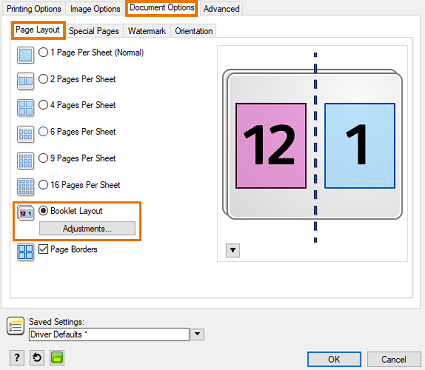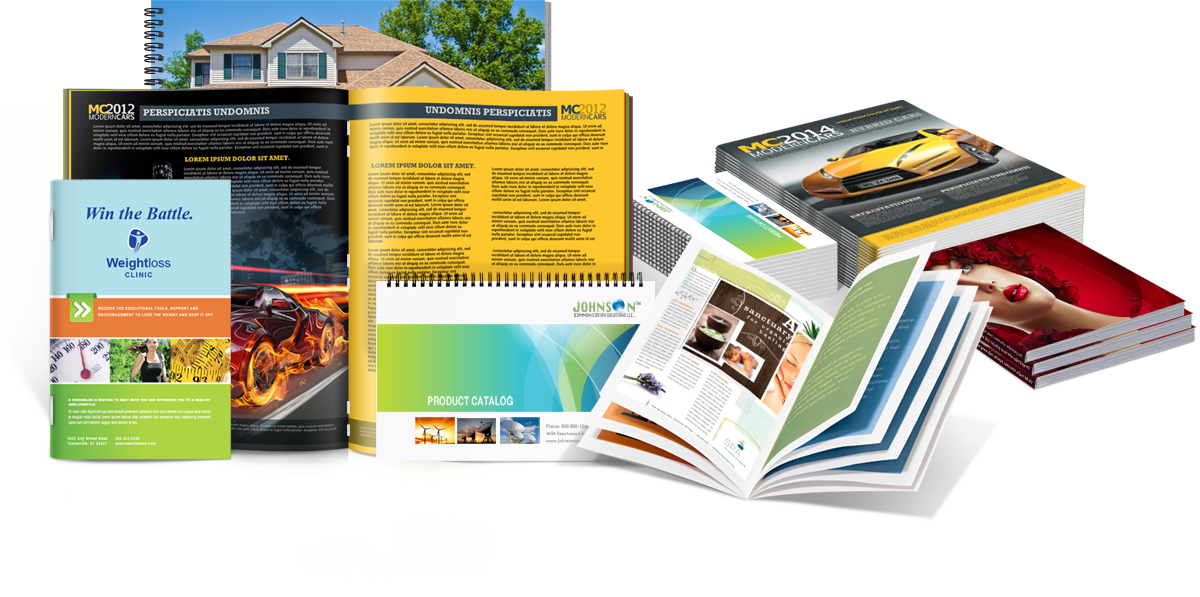The Essential Overview to Understanding Booklet Printing Options and Techniques
The process of booklet printing entails several considerations that can greatly influence the last item. From picking the appropriate style and dimension to recognizing the subtleties of binding methods, each option plays an important role. Furthermore, variables such as paper stock and printing strategies more influence the efficiency of the booklet. As one navigates these alternatives, it ends up being essential to realize exactly how they adjoin and what that implies for the general result.
Recognizing Pamphlet Styles and Dimensions
When taking into consideration brochure printing, recognizing the different layouts and sizes readily available is crucial for accomplishing the wanted discussion. Pamphlets can be generated in countless styles, including saddle-stitched, spiral-bound, and perfect-bound, each offering distinct benefits. Typical dimensions range from standard letter (8.5 x 11 inches) to smaller sized choices like A5 (5.8 x 8.3 inches), allowing for versatility based on material and target audience.Selecting the ideal size can influence both the design and reader involvement. Larger sizes could fit visually driven web content, while smaller formats may be a lot more easy to use and portable. Additionally, the variety of pages influences the choice of binding technique, as thicker pamphlets might call for sturdier bindings. Ultimately, comprehending these aspects permits a more customized method, making sure that the end product lines up with the intended message and visual, enhancing the general efficiency of the communication.
Picking the Right Paper Stock

Binding Techniques: Factors To Consider and options
When it comes to binding approaches for brochures, a number of choices are available, each with distinct advantages. Saddle stitch binding supplies a cost-efficient option for thinner booklets, while best binding techniques give an even more sleek seek thicker publications. Wire-O binding attracts attention for its sturdiness and convenience of usage, making it optimal for files that need adaptability.
Saddle Stitch Binding
Saddle stitch binding uses a affordable and practical solution for setting up pamphlets, making it a preferred option among services and publishers. This binding technique involves folding sheets of paper in fifty percent and stapling them along the fold line, developing a well organized and cool appearance. Commonly ideal for booklets with a reduced web page count, saddle sewing is ideal for publications, brochures, and educational products. The simplicity of this technique enables quick production and is frequently preferred for short runs or marketing items. It is necessary to keep in mind that saddle stitch binding might not be appropriate for thicker pamphlets, as the spine may not hold up under increased weight. In general, it continues to be a reputable alternative for many printing projects.
Perfect Binding Techniques
Perfect binding is a commonly made use of strategy that supplies a professional and sleek finish to pamphlets and publications. This approach involves gluing the pages with each other at the spinal column making use of a solid adhesive, permitting for a tidy edge and the capability to hold a larger number of web pages compared to saddle sewing. Perfect binding is particularly appropriate for thicker pamphlets, such as brochures and yearly records, where a sturdy, level back is preferred. In addition, it offers the choice for a published cover that can be designed to improve aesthetic appeal. Nevertheless, factors to consider such as web page matter, paper weight, and the intended use of the brochure need to be taken into account, as they can impact resilience and general top quality.
Wire-O Binding Options
Wire-O binding, known for its sturdiness and adaptability, offers an exceptional choice for brochures that call for very easy page transforming and a specialist look. This binding technique utilizes a collection of metal loops that hold pages securely, allowing them to lie flat when open. It is particularly suitable for brochures, discussions, and handbooks due to its robust nature. Wire-O binding is available in various shades and sizes, fitting different page matters and densities. Additionally, it permits the incorporation of covers and tabs, enhancing the booklet's total visual. Considerations for Wire-O binding consist of the selection of cord color, the size of the loopholes, and the degree of modification desired, every one of which can profoundly influence the final item's look and functionality.
Digital vs. Offset Printing: Which Is Best for You?
When picking a printing technique for booklets, understanding the differences in between digital and counter printing is crucial. Digital printing makes use of modern innovation to generate top quality prints promptly and affordably, making it suitable for short runs or jobs requiring quick turnaround times. It permits customization, giving the capability to publish on-demand with very little waste.In contrast, offset printing is a traditional technique that excels in creating huge amounts with constant top quality. It includes moving ink from a plate to a rubber covering, then to the paper, which causes exact details and dynamic colors. However, counter printing generally needs longer configuration times and is much more economical for larger volumes.Ultimately, the choice between digital and counter printing depends on job needs, spending plan, and desired quantity. For tiny, time-sensitive projects, digital may be the finest selection, while countered might be preferable for larger, premium manufacturings.

Designing Your Brochure: Tips and Best Practices
When making a pamphlet, cautious interest to layout, font option, and shade usage can greatly boost its efficiency. A well-structured design guides the viewers's eye, while appropriate typefaces ensure readability and share the wanted tone. Furthermore, efficient use of color can stimulate emotions and emphasize crucial information, making the total style much more impactful.
Choosing the Right Design
How can one efficiently pick the ideal design for a booklet? It is necessary to assess the pamphlet's function and target audience. A tidy, organized format improves readability and involvement. Making use of a grid system can assist in straightening components constantly, creating an expert appearance. Additionally, integrating aesthetic hierarchy via varying dimensions and placements of pictures and message can direct the visitor's eye and stress essential details. It is also crucial to leave sufficient white area, which avoids congestion and enables much better emphasis. Evaluating various formats via mock-ups can give insight into exactly how the style does in real-world circumstances, making sure that the last item fulfills both functional and aesthetic needs.
Selecting Suitable Font Styles
A well-chosen font style can considerably enhance the overall design of a brochure, matching the design and strengthening the web content's message. The option of fonts need to consider readability, especially for body text, as it assures the details comes to all readers. Sans-serif fonts are usually preferred for electronic formats, while serif fonts can provide a traditional feel in published products. It's a good idea to restrict font choices to two or 3 to maintain visual coherence. In addition, font size plays an essential role; headings must be distinctive yet not overwhelming, while body message ought to be comfortable for reading. When choosing fonts, placement with the pamphlet's theme and target audience is crucial for effective interaction and aesthetic appeal.
Effective Use of Shade
Color works as a powerful device in brochure layout, guiding and shaping assumptions visitor feelings. It can evoke sensations of exhilaration, trust, or calmness, relying on the colors selected. Developers ought to think about shade concept principles, guaranteeing that the chosen combination straightens with the pamphlet's message and target market. As an example, using cozy colors like red and orange can produce necessity, while cooler tones like eco-friendly and blue foster tranquility.Additionally, contrast plays an essential duty; corresponding shades can boost readability and aesthetic allure. Consistency in color get more usage throughout pages further reinforces brand name identity and communication. Eventually, reliable shade implementation not only records focus yet also reinforces the brochure's objective, making it an essential aspect of successful layout.
Ending Up Touches: Coatings and Unique Effects
While lots of take into consideration the material and layout of a brochure one of the most essential elements, the ending up touches, such as coatings and unique results, play an essential duty in enhancing its total charm. Coatings can give protection and durability, making certain that the brochure holds up against damage. Matte coatings offer an innovative, non-reflective surface, while glossy layers can make colors appear more vibrant and appealing. Unique results, like embossing or aluminum foil stamping, include a tactile measurement that can create a memorable impression. These methods can highlight specific locations, accentuating important details or developing aesthetic rate of interest. In addition, UV finish can supply a high-shine surface that elevates the overall look.Together, these finishing touches not just boost the booklet's visual but additionally connect professionalism and trust and interest to information, eventually leaving a long lasting influence on the viewers.
Price Considerations for Brochure Printing
Understanding the various cost factors to consider for pamphlet printing is essential for companies and organizations intending to enhance their budget plans. Secret aspects influencing you can find out more expenses consist of the selection of ink, binding, and paper methods. Higher high quality products, such as exceptional paper or specialized inks, commonly raise the general cost. In addition, the size and page count of the booklet play a substantial role; larger pamphlets need more sources and time to produce.Another crucial factor to consider is the printing strategy, whether electronic or countered, as each has its own pricing framework and viability for various amounts. Organizations need to likewise consider style expenses, which can differ based on complexity and making use of expert solutions. Ultimately, shipping and handling charges can include in the total, particularly for large orders. By examining these components, companies can make informed choices that straighten with their economic capacities while attaining the preferred high quality in their printed products.
Regularly Asked Questions
What Are the Environmental Influences of Brochure Printing?
The environmental impacts of booklet printing consist of logging from paper manufacturing, carbon exhausts from transport, and waste generation from thrown out products - Booklet Printing. Lasting practices, such as using recycled paper and environmentally friendly inks, can minimize these results
How Can I Ensure Color Precision in My Pamphlet?
To assure shade accuracy in a booklet, one must make use of adjusted monitors, use specialist shade profiles, carry out test prints, and select high-quality printing solutions that provide shade matching and proofing choices for best outcomes.
What Is the Common Turn-around Time for Brochure Printing?
The typical turn-around time for booklet printing varies relying on the intricacy and quantity - Booklet Printing. Normally, it ranges from a few days to 2 weeks, influenced by variables such as printing techniques and completing requirements
Exist Minimum Order Quantities for Brochure Printing?

Can I Print Pamphlets in Multiple Languages?
Publishing booklets in several languages is feasible. Many printing solutions supply alternatives for bilingual or multilingual layouts, permitting efficient communication. Mindful planning guarantees that design elements accommodate various languages without compromising readability or aesthetic appeals. In addition, variables such as paper supply and printing strategies more affect the performance of the brochure. When taking into consideration pamphlet printing, comprehending the numerous layouts and dimensions available is necessary for attaining the wanted discussion. When choosing a printing method for booklets, understanding the differences in between digital and offset printing is essential. Additionally, the dimension and web page count of the pamphlet play a substantial function; larger pamphlets call for more resources and time to produce.Another vital factor to consider is the printing method, whether electronic or offset, as each has its own pricing framework and suitability for different quantities. The ecological impacts of booklet printing consist of deforestation from paper production, carbon exhausts from transportation, and waste generation from discarded products.